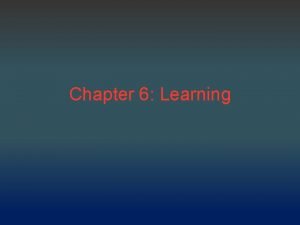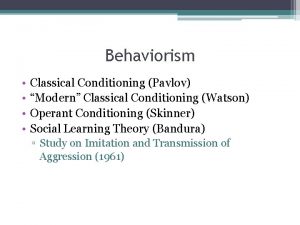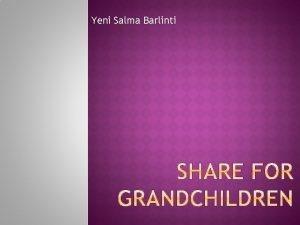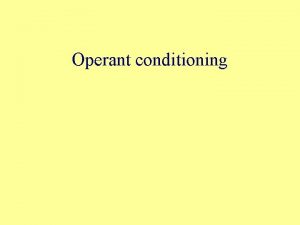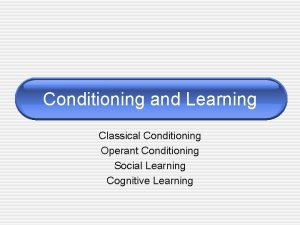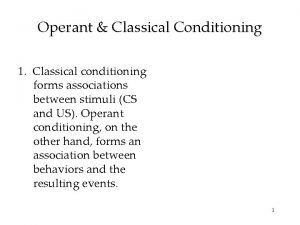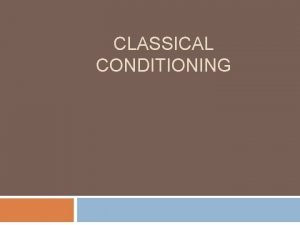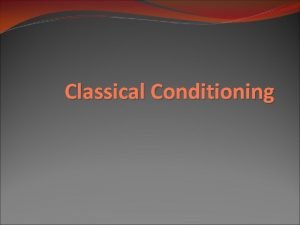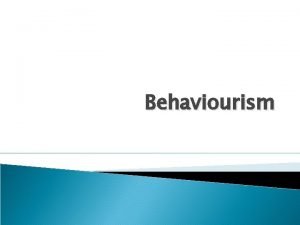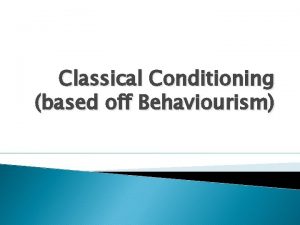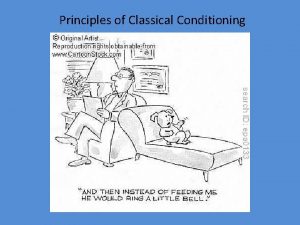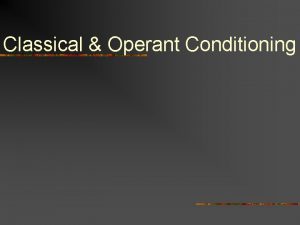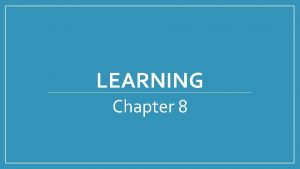11 Classical Conditioning Dr Salma Classical Conditioning Early














- Slides: 14

11. Classical Conditioning Dr. Salma

Classical Conditioning � Early 20 th century, Russian physiologist Ivan Pavlov (1849– 1936) was studying the digestive system of dogs when he noticed an interesting behavioral phenomenon: The dogs began to salivate when the lab technicians who normally fed them entered the room, even though the dogs had not received food- psychic reflex. � Later he designed experiment to study this phenomenon and called it as Classical conditioning.

� Classical conditioning was developed by Russian physiologist Ivan Pavlov. � Classical conditioning refers to learning that occurs when a neutral stimulus (e. g. , a tone) becomes associated with a stimulus (e. g. , food) that naturally produces a behavior. After the association is learned, the previously neutral stimulus is sufficient to produce the behavior. � It is a form of learning in which a neutral stimulus comes to elicit a response that it doesn’t. But after being associated/ paired with a (natural) stimulus that already elicit that response it acquires the capacity to elicit the same response.

Psychologists use specific terms to identify the stimuli and the responses in classical conditioning. � Unconditioned stimulus (US) is something that triggers a natural occurring response. In C. C. a stimulus (such as food) that naturally elicit a particular natural( unconditioned) response. � Unconditioned response (UR) is the naturally occurring response (such as salivation) that follows the unconditioned stimulus. � Conditioned stimulus (CS) is a neutral stimulus that, does not elicit a response before conditioning In Pavlov’s experiment, the sound of the tone served as the conditioned stimulus that, after learning, produced the � Conditioned response (CR) Learned response given to a particular CS. In Pavlov’s experiment, salivation to sound of tone. � UR and the CR are the same behavior—in this case salivation—but they are given different names because they are produced by different stimuli (the US and the CS, respectively).


Before conditioning Food (US) Salivation ( UR) Tone (NS) No Salivation (No CR) During Conditioning Tone + Food (NS) (US) Salivation (UR) After Conditioning Tone (CS) Salivation (CR) For classical conditioning to occur, the CS must be a reliable predictor of the US; that is, there must be a higher probability that the US will occur when the CS has been presented than when it has not.

� In classical conditioning, a person or animal learns to associate a neutral stimulus (the conditioned stimulus, or CS) with a stimulus (the unconditioned stimulus, or US) that naturally produces a behavior (the unconditioned response, or UR). As a result of this association, the previously neutral stimulus comes to elicit the same response (the conditioned response, or CR). � Learning situation in C. C. is called S-S learning in which one stimulus (tone) becomes a signal for another stimulus (food).

� Generalization refers to the tendency to give CR to stimuli that resemble the original conditioned stimulus. In C. C. CR may occur in response to stimuli that are similar to the CS but have never been paired with CS this is called stimulus generalization. eg. a dog conditioned to salivate to the dinner bell would also salivate to the sound of door bell or phone bell. � Stimulus Discrimination—the tendency to � respond differently to stimuli that are similar but not identical. eg. In C. C. when CR (salivation) only occur in response to CS ( sound of tone) not to a stimulus similar to it is called Stimulus Discrimination

Principles of Classical conditioning. � Acquisition- the process by which CS acquires the ability to elicit a CR through repeated pairing of CSUCS is called acquisition. � Extinction refers to the reduction in responding that occurs when the conditioned stimulus is presented repeatedly without the unconditioned stimulus. � This is the process of learning to inhibit the response acquired in conditioning. � Extinction occurs when the CS is repeatedly presented without the US, and the CR eventually disappears, although it may reappear later in a process known as spontaneous recovery. Eg …. � Spontaneous recovery: The gradual reappearance of CR after a period of time that has been subjected to extinction is called spontaneous recovery. Eg …

� In some cases, an existing conditioned stimulus can serve as an unconditioned stimulus for a pairing with a new conditioned stimulus—a process known as second-order conditioning. � In one of Pavlov’s studies, for instance, he first conditioned the dogs to salivate to a sound, and then repeatedly paired a new CS, a black square, with the sound. Eventually he found that the dogs would salivate at the sight of the black square alone, even though it had never been directly associated with the food.

• Stimulus generalization occurs when a stimulus that is similar to an alreadyconditioned stimulus begins to produce the same response as the original stimulus does. • Stimulus discrimination occurs when the organism learns to differentiate between the CS and other similar stimuli. • In second-order conditioning, a neutral stimulus becomes a CS after being paired with a previously established CS. • Some stimuli—response pairs, such as those between smell and food—are more easily conditioned than others because they have been particularly important in our evolutionary past.

Factors affecting Conditioning � Conditioning was determined by number of CS-US pairing. There will be sufficient no of pairing. This process is also affected by other factors. � The extent with which a CS precedes or follows the presentation of US can affect CR (Temporal arrangement of CS-US affects the acquisition of a CR). There may be 4 types of arrangement: � Delayed conditioning- the CS is presented ist and remains at least until the onset of the US. In Pavlov’s p tone is presented ist and remains on till the meat powder is placed on the tongue thus CS and US overlaps. It produced strong cond.

� Trace Cond- The CS is presented ist and end before the onset of the US. In Pavlov’s p ist the tone is presented and then turned off before the meat powser is presented. (It produced moderately strong cond. ) Simultaneous Cond- the CS and US begins together. In Pavlov’s p tone and food presented together. (Weak cond) � Backward Cond- the onset of US precedes the onset of CS and remains atleast untill the onset of the US. � In Pavlov’s p ist the food is presented ist and followed immediately by tone. (least effective)

� In general conditioning is faster when the intensity of either stimulus is CS or US increases. � It also depends on the time interval between the presentation of the two stimuli. ü -Extremely short interval<. 2 sec. rarely produce cond. ü - In animal the optimal interval between CSUS -. 2 to 2 sec. ü -Longer time interval are difficult to recognize the CS as a signal for some future event. � Novel and unusual stimulus are good for CS. *******
 Operant conditioning classical conditioning
Operant conditioning classical conditioning Partial schedule of reinforcement
Partial schedule of reinforcement Fixed-ratio schedule example
Fixed-ratio schedule example Classical conditioning vs operant
Classical conditioning vs operant Operant vs classical conditioning
Operant vs classical conditioning Operant vs. classical conditioning
Operant vs. classical conditioning Operant vs classical conditioning
Operant vs classical conditioning Classical conditioning vs operant conditioning
Classical conditioning vs operant conditioning When was the little albert experiment
When was the little albert experiment Operant vs. classical conditioning
Operant vs. classical conditioning Salma berrada souni
Salma berrada souni Contoh soal teori kinetik gas
Contoh soal teori kinetik gas Gcg adalah
Gcg adalah Yeni salma barlinti
Yeni salma barlinti Yeni salma barlinti
Yeni salma barlinti




